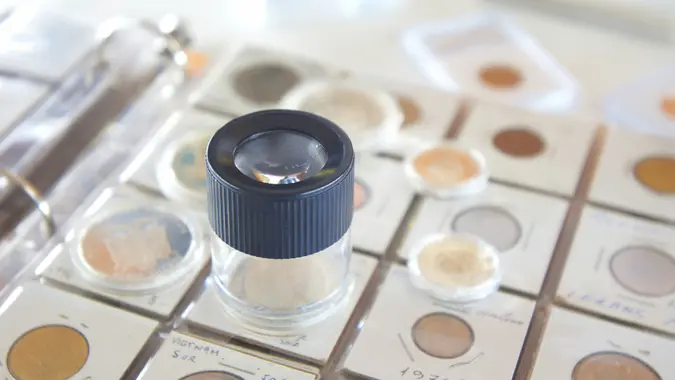Advertiser Disclosure
GOBankingRates works with many financial advertisers to showcase their products and services to our audiences. These brands compensate us to advertise their products in ads across our site. This compensation may impact how and where products appear on this site. We are not a comparison-tool and these offers do not represent all available deposit, investment, loan or credit products.
19 Fascinating Facts You Never Knew About the Penny
 Written by
Erica Corbin
Written by
Erica Corbin

Commitment to Our Readers
GOBankingRates' editorial team is committed to bringing you unbiased reviews and information. We use data-driven methodologies to evaluate financial products and services - our reviews and ratings are not influenced by advertisers. You can read more about our editorial guidelines and our products and services review methodology.

20 YearsHelping You Live Richer

Reviewed by Experts

Trusted by Millions of Readers
Four score and 30 years ago — that’s 1909 for those of you who haven’t watched “National Treasure” recently — President Abraham Lincoln became the face of the penny. And, while technology is transforming the way we pay for things — arguably making cash less and less practical — Lincoln’s little coin that could has stuck around for a surprisingly long time.
The 1-cent coin’s longevity isn’t the only interesting fact about it, however. Here are some of the surprising things you probably never knew about your money.
A Woman Used To Be the Face of the Penny
Long before Lincoln became synonymous with the 1-cent coin, a fictitious person graced the front. Miss Liberty, a gal with long, flowing locks, became the face of the penny after a conference held in the U.S. House. The decision was made against the wishes of the Senate, who wanted George Washington on the front.
Pennies Used To Be Much Bigger
Today, pennies are about the same size as dimes — America’s smallest coin — but they weren’t always that small. In fact, the original penny was about the size of today’s half dollar. Pretty strange when you consider it’s the smallest form of currency.
Despite Its Color, the Penny Has Hardly Any Copper in It
From 1793 to 1857, the 1-cent coin was made out of pure copper, but due to the increasing price of the metal, other elements were added to the mix. Over the years, nickel, tin, zinc and steel have all been used. Today, the penny is made with mostly zinc and only 2.5% copper.
The First Batch of Pennies in Circulation Totaled Just Over $100
The U.S. Mint first released pennies into circulation in March 1793. There were 11,178 coins — $111.78 in sum.
‘Birch Cents’ Were One of the Earliest Penny Designs
In 1792, artist William Russell Birch designed some of our earliest pennies, which featured Miss Liberty on the front and a laurel wreath on the back. The design of the penny ended up changing before it formally went into production, so the so-called “Birch Cents” or “Birch Pennies” are exceedingly rare. In fact, in October 2018, one of the historical coins was put up for auction at Stack’s Bowers Galleries in California for $1 million.
People Thought Miss Liberty Needed a Makeover
Miss Liberty’s coin received the unfortunate nickname “Silly Head” because the public thought the woman’s appearance was odd. Later versions of the coin gave her a ribbon to wear in her hair and eventually a cap of sorts. Her curls also became far less unkempt. It seems Americans just didn’t like the idea of a woman having bedhead.
The Penny Has British Roots
The penny gets its name from the British “penny,” which Americans had been accustomed to using, having immigrated from the Kingdom of Great Britain. However, while we call multiple 1-cent coins “pennies,” the British call multiples of their penny “pence.”
Lincoln Was the First Real Person To Be Featured On the Penny
In 1909, when Lincoln became the face of the penny, it marked the first time a real human — as opposed to someone fictitious or an animal — appeared on regular-issued coinage. Further, despite being the 16th president of the country, Lincoln was the first president to be on a coin.
Lincoln Isn’t the Only Historical Figure Associated With the Penny
Lincoln isn’t the only big name tied to the coin. Founding Father Benjamin Franklin, who is associated with the famous phrase, “A penny saved is a penny earned,” designed one of the earliest U.S. pennies, called the Fugio cent. The association between pennies and Franklin is so strong that visitors to his grave in Philadelphia often leave pennies there for good luck.
The Penny Once Featured Two Lincolns
From 1959 to 2007, both sides of the penny featured Lincoln. On the front of the design is his bust, and on the back, his tiny figure can be seen within the Lincoln Memorial.
Lincoln’s Penny Has Had Several Makeovers
The penny has undergone several design changes over the years, with four being used in 2009 alone. The four designs highlighted important phases of Lincoln’s life: his birth and early childhood in Kentucky, youth in Indiana, a career in Illinois and, finally, the presidency in Washington, D.C.
2009 Was a Special Year for the Penny
The reason the penny featured four different designs in 2009 was to commemorate two very special occasions. That year was the 200th anniversary of Lincoln’s birthday, as well as the 100th anniversary of his appearance on the 1-cent coin.
The Union Shield Is an Ode to Lincoln
In 2010, a new design was introduced on the back of the penny: the Union shield. The shield has been used on many medals and currency over the years, including the 2- and 5-cent coins. However, this time it was used to commemorate Lincoln’s preservation of the U.S. as a single country.
Americans Didn’t Come Up With the Term ‘Penny-Pinching’
The term “penny-pinching” was not — pardon the pun — coined by Americans. It was first used in Tomas Dekker’s play, “Shoemaker’s Holiday” in 1600, and it was around long before America was officially founded. The phrase didn’t catch on in the U.S. until the 20th century, more than 100 years after the penny was introduced to Americans.
Pennies Weren’t Always Copper-Colored
Before the pennies we know today, there were “white cents.” Their metal composition made them white in appearance. The coins were 88 parts copper and 12 parts nickel.
Pennies and Dimes Were Once Confused With Each Other
In 1943, copper was needed for war materials, so pennies needed to be made out of a new metallic element. The U.S. decided to make them out of zinc-coated steel instead. Since the color was silvery, the coins were often confused with dimes.
Paul Revere Helped Make Some of the Country’s Pennies
Some might not realize that Paul Revere was a silversmith. In fact, he had his own metals company that once supplied the U.S. Mint with rolled copper to make 1-cent coins.
Congress Said Goodbye to Foreign Money When the Penny Changed Faces
In 1857, as the country shifted from the pure copper Miss Liberty coin to a smaller, copper-nickel coin with an eagle on the front, Congress decided to ban the use of foreign currency. Previously, money from other countries had regularly been used.
You Can Get a Special Penny This Year
This year, the U.S. Mint is selling The 2019 United States Mint Proof Set, which includes a special edition 2019 Lincoln penny with a “W” mint mark. The “W” indicates that the coin was made at the West Point Mint in New York.
More on the Economy
- Why Happy People Earn More Money
- How to Save Money on All Your Monthly Expenses and Bills
- 12 Essential Money Tips for Every Phase of Your Financial Life
- Robert Mueller’s Facebook Stock Investments and 8 More Money Facts
Priscilla Aguilera contributed to the reporting for this article.
Share this article:




You May Also Like

4 Grocery Items That Have Gotten Much More Expensive Since Trump Took Office
December 02, 2025
6 min Read


If You Earn $100K a Year, Here's Where You Actually Rank Among All Americans
December 02, 2025
6 min Read


If the Top 10 Billionaires' Wealth Was Distributed Equally in America, How Much Money Would Each Person Get?
December 03, 2025
6 min Read

22 States in or Near a Recession Right Now -- and What It Means for Residents
December 03, 2025
6 min Read

5 Key Signs You've Been Hacked -- and What To Do Next To Protect Your Money
December 03, 2025
6 min Read

These 6 Career Skills Increase Your Chances of Earning More Money, According to Experts
December 03, 2025
6 min Read

4 Mistakes To Avoid If You Find an Old Coin or Bill That Could Be Valuable
December 03, 2025
6 min Read




Questions Around The Economy
Make your money work for you
Get the latest news on investing, money, and more with our free newsletter.
By subscribing, you agree to our Terms of Use and Privacy Policy. Unsubscribe at any time.


Thanks!
You're now subscribed to our newsletter.
Check your inbox for more details.



Sending you timely financial stories that you can bank on.
Sign up for our daily newsletter for the latest financial news and trending topics.
For our full Privacy Policy, click here.
Looks like you're using an adblocker
Please disable your adblocker to enjoy the optimal web experience and access the quality content you appreciate from GOBankingRates.
- AdBlock / uBlock / Brave
- Click the ad blocker extension icon to the right of the address bar
- Disable on this site
- Refresh the page
- Firefox / Edge / DuckDuckGo
- Click on the icon to the left of the address bar
- Disable Tracking Protection
- Refresh the page
- Ghostery
- Click the blue ghost icon to the right of the address bar
- Disable Ad-Blocking, Anti-Tracking, and Never-Consent
- Refresh the page





